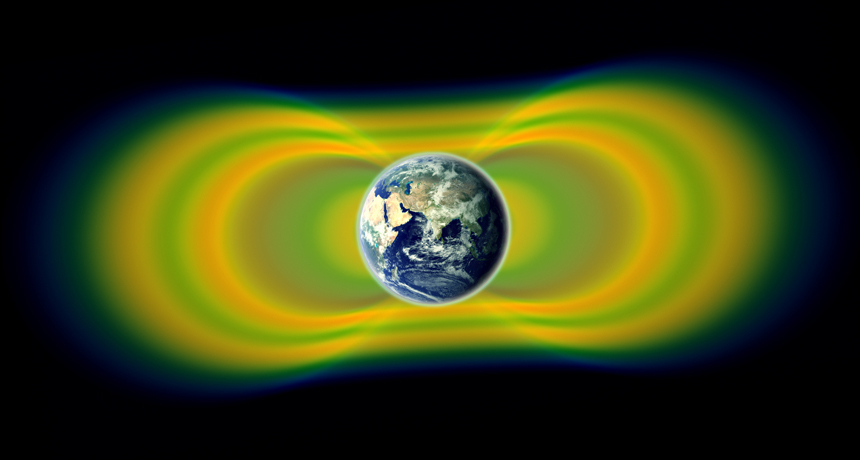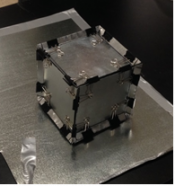Student radiation experiment goes to space
The Orion Exploration Design Challenge will send a winning radiation-shielding experiment to space

Giant bands of charged particles, known as the Van Allen Belts, surround Earth. They are illustrated here in yellow, with green representing the spaces between them. A team of high-schoolers won the opportunity to send its radiation-shielding experiment through the belts.
NASA/Van Allen Probes/Goddard Space Flight Center
WASHINGTON — In many of our favorite space adventure movies, it takes an astronaut to save us all. A lone hero may fly his spacecraft out to thwart alien invaders. Or a group of intrepid astronauts might destroy a meteoroid headed for Earth. But while those astronauts are saving us, they face their own danger: radiation.
On Earth, we are surrounded by a magnetic field. It protects our planet from cosmic rays, harmful radiation that can increase our risk of cancer. But in space, outside the magnetic field, astronauts have little protection from those cosmic rays. Astronauts may save us from asteroids and aliens in fiction, but who will protect real astronauts from the threat posed by radiation?
For a job like this, you need high school students.
In December of 2014, NASA and the Bethesda, Md.-based aerospace company Lockheed Martin will launch the first Exploration Flight Test (EFT-1) of the Orion Program. That program is designing vehicles to ferry crews further into space than ever before. This means that astronauts will be spending more time exposed to those cosmic rays.

Onboard EFT-1 will be a small payload from a team of students at Governor’s School for Science and Technology in Hampton, Va. The teens won the Exploration Design Challenge. Forty-six teams from all over the United States competed in this year-long program to conduct experiments to space. The winning team was honored Friday, April 25, during a ceremony at the USA Science and Engineering Festival in Washington, D.C.
The team’s winning design got the highest score in an online simulation of radiation protection. The small box, only about 20 centimeters (eight inches) on each side, may not look like much. But it’s full of tantalum, tin, aluminum, zirconium and polyethylene to block radiation. It also contains a dosimeter, which will measure how much radiation gets into the box. When EFT-1 returns to Earth, the students will analyze data from their device to determine whether the materials performed as well as the simulator had predicted. If successful, their experiment might one day influence the shielding of future spacecraft.
While only one experiment will go into space, NASA is still inviting students to take part in the Exploration Design Challenge. There is separate registration for entries from students in kindergarten through fourth grade, in fifth- to eighth grades and in high school. Online resources help students learn about radiation in space and how to analyze materials for radiation shielding. Classes who complete the challenge by June 30 will have their names flown aboard EFT-1 as virtual crew members.
Power Words
aluminum A metallic element, the third most abundant in Earth’s crust. It is light and soft, and used in many items from bicycles to spacecraft.
astronaut People trained to travel into space for research and exploration.
cosmic rays Very high-energy particles, mostly protons, that bombard Earth from all directions. These particles originate outside our solar system. They are equivalent to the nucleus of an atom. They travel through space at high rates of speed (often close to the speed of light).
dosimeter A device that measures the accumulating exposure to some substance or feature, such as radiation.
meteor A lump of rock or metal from space that hits the atmosphere of Earth. In space it is known as a meteoroid. When you see it in the sky it is a meteor. And when it hits the ground it is called a meteorite.
ozone A colorless gas that forms high in the atmosphere and at ground level. When it forms at Earth’s surface, ozone is a pollutant that irritates eyes and lungs.
payload The weight that a spacecraft can carry, including people, scientific instruments and other equipment. It is usually important to keep the payload low. This will cut the amount of fuel needed to get a spacecraft off the ground.
polyethylene The most common plastic in the world. Flexible and tough, it also can resist radiation.
radiate (in physics)To emit energy in the form of waves.
radiation The transfer of energy (as particles or waves). Some types (such as alpha, beta and gamma radiation) can damage cells by depositing high levels of energy in them. This can pose a health risk to affected organisms.
tantalum A metallic element used in electronics, such as computers and DVD players.
tin A metallic element with the atomic number 50..
van Allen belts Two belts, an inner and outer one, surrounding Earth. They consist of cosmic rays — charged particles (electrons and protons). The belts extend from about 13,000 to 60,000 kilometres (8,100 to 37,300 mi) above the planet’s surface. The high energy particles, a type of radiation, vary over time and altitude and pose a health risk to exposed space travelers.
virtual Being almost like something. Something that is virtually real would be almost true or real — but not quite. The term often is used to refer to something that has been modeled by or accomplished by a computer using numbers, not by using real-world parts. So a virtual motor would be one that could be seen on a computer screen and tested by computer programming (but it wouldn’t be a three-dimensional device made from metal).
zirconium A metallic element that is often used in structures needed to withstand high temperatures and radiation (such as nuclear reactors).







